1962, the infancy of X-ray astronomy....Sure, astrophysicists knew that X-rays are produced in the stupendous inferno deep inside the Sun, but they also knew that its X-ray output was miniscule when compared with the visible light that the Sun emits. In order to see X-rays from other stars that are hundreds of light years away, these stars would have to produce a million times more energy in X-rays than the Sun does. No one thought it likely, most thought it impossible. One thing was certain: if it ever happened, it simply could not be an ordinary star....
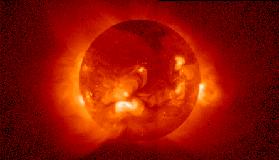
The Sun in X-ray light
-Bruno Rossi
Five or six precious minutes. That's all the observing time you got in the
"olden days". You fired a 50 ft. bullet (better known as an Aerobee sounding rocket) into the sky, fueled with
Red Fuming Nitric Acid, and Analine. This stuff really didn't get cooking until
about 5 seconds after the launch, so you stuck on an 8 ft. solid fuel booster
underneath; quite a large firecracker indeed.
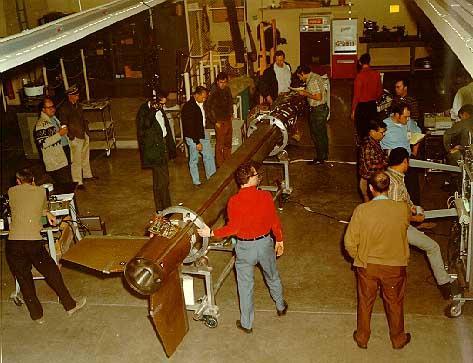
Final Prelaunch Tests of Aerobee sounding rocket.
The payload preparation has taken years. Months ago, it had been placed on the "shake table" at NASA, where the stresses of launch were simulated. Geiger counters that would function in much the same way that film does in an ordinary camera, had been painstakingly calibrated and checked in the laboratory. Finally you mate this X-ray camera with the Aerobee. To check all the systems, you do a "horizontal test". The countdown is simulated, and you make sure that all systems are operating properly. The only thing you can never really check is the engine system; the vehicle stays empty until it is fueled in the tower on the day of launch.
Then, a few days later, comes "vertical". The rocket and payload are placed into the tower, and the launch sequence is simulated once more. All systems are go!...Finally, launch day arrives.
There is a frenzied excitement in the air. The energy is high. The rocket is fueled. (If it is a hot day, the poor people who do this in heavy, everything-proof rubber will lose 20-30 pounds of weight in the process). The countdown begins...
It takes a few minutes to get to the 100 mile altitude that is necessary to be sure that the X-rays get into your detectors instead of being absorbed by the Earth's atmosphere. Plenty of time to agonizingly anticipate the observation and reflect upon the two previous attempts which failed, once when the rocket engine misfired, and again when the rocket door to the detector failed to open. In the two years that followed the first failure, Riccardo Giacconi's team at American Science and Engineering in Cambridge, Massachusetts had developed a detector a hundred times more sensitive than any ever flown before. It is this new improved payload that is now being launched.
The time has come. For several hundred seconds on the 18th day of June, 1962, the rocket will sweep the sky, looking at our Moon. What?! X-rays from the MOON????
Yes, the Moon shines by reflected light of the Sun, so a certain fraction of the Sun's X-rays will be reflected off the lunar surface, back toward the Earth, and the rocket. It was logical to look at the Moon as the next step in exploring the X-ray universe. Not glamorous, not spectacular, certainly, but LOGICAL.

The Moon in visible light
When the rocket attains a height of about 100 miles, the gyros, still carrying their memories of the rocket's orientation on the launch pad, now instruct the Attitude Control System to manuever the payload so that the detectors are pointing toward the selected target. And so the AS&E team anxiously waited as the rocket rolled, pitched, and yawed its way toward the direction of the Moon in the sky, one day past full, and 35 degrees above the New Mexico horizon, glittering the desert with its visible light. Up higher goes the rocket, hopefully to capture some of those elusive X-rays that would otherwise silently be absorbed by the Earth's atmosphere.
Almost immediately, an enormous spike appeared on the chart recorder, as the rocket spun round and round, looking at the Moon and elsewhere in the sky as well. Rather than being jubilant, team member Herb Gursky was initially dismayed. "Oh, no!" he shouted. His tone was dejected because he knew that the Moon would NEVER be that bright in X-rays. However, after a few minutes, he realized that the spike that was seen over and over again as the rocket X-ray detectors swept over the sky, was not from the Moon at all, but actually came from another part of the sky, about 25 degrees away! (The Moon would have produced a maximum in the graph at about position 160 degrees, whereas the peak occurs at about 185 degrees). It turned out that the Moon's X-ray brightness contributes virtually nothing to the count rate we see displayed below.
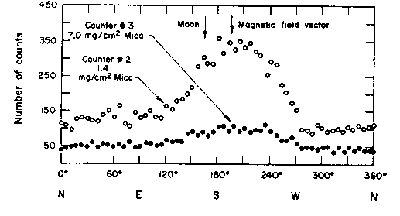
An X-ray source is discovered

The arrow above points to the new X-ray source
(seen here in a conventional visible light photo)
After several months of analysis back at their laboratory in Cambridge,
Massachusetts, Giacconi, Gursky, and Frank Paolini reached a surprising, but
unmistakable conclusion: the signal was real, not an equipment malfunction, and
not from the Moon. It was from a cosmic source of X-rays of truly staggering
proportions. From the depths of space, came X-rays so plentiful that they
exceeded the Sun's entire energy output by a factor of 100, and exceeded its
X-ray output by a factor of about one hundred million!
It was a totally new type of object, dubbed SCO X-1 (for the first X-ray source to be discovered in the constellation of Scorpius). This and subsequent rocket flights soon made it clear that Nature is showering us with X-rays from virtually everywhere (Astronomers have since discovered thousands of these X-ray sources. Although far more luminous than Sun, they are so distant that even SCO X-1, the source with the highest apparent X-ray brightness, sends to the Earth each second less than one billionth of the energy you receive in a single dental X-ray photo. (And that even assumes that all of the SCO X-rays penetrate the Earth's atmosphere instead of being absorbed by it).
After the discovery, the search was on in the sky to see which "star" was giving off the X-ray light. The answer was not long in coming; a completely obscure but very peculiar blue object in the constellation of Scorpius was the culprit. The arrow in the sky photo below marks the spot.
The dam had burst. On Oct. 15, 1967 Walter Lewin and collaborators at MIT observed SCO X-1 and discovered the first extra-solar X-ray flare ever. So now we found out that these X-ray stars could change their brightness in just a few minutes! Soon rocket flight after rocket flight revealed more of these strange objects, and theoretical astrophysicists realized that neutron stars were responsible for the stupendous energy generated by many of these cosmic X-ray beacons. A whole new field of science had been born, galactic X-ray astronomy. It was (and is) a world of binary stars with exciting phenomena that are still being uncovered by the latest generation of X-ray telescopes being flown now, 35 years after the first observation of SCO X-1...

An X-ray binary star...the x-rays come from the object on the right
Interestingly enough, although SCO X-1 was the first discovered source, and the one with the greatest X-ray brightness in the sky, it has been reluctant to reveal its secrets. It was only many years later that scientists found convincing evidence for its binary nature, even though they were quite certain that there must be a companion star.
Now, we have satellites that allow us to observe the sky for far longer than five minutes, thereby opening up new time domains for studying potentially exotic behavior. Orbiting X-ray telescopes provide much more complete coverage and sensitivity, and SCO X-1 has obliged us...
A scant ten years ago, a strange signal was detected from SCO X-1, (as well as from certain other X-ray sources). Named "quasi-periodic oscillations" (or QPO's), these elusive pulses of X-rays come and go like the wind, lasting a few hundred seconds, only to return and do the same thing again, but slightly differently each time. During these hundred second outbursts, the light comes and goes much like a rotating lighthouse beacon, about once every second.
We already know that these phenomena come only from a class of objects called low-mass X-ray binaries, of which SCO X-1 is a member. However, the exact nature of the processes that give rise to these peculiar signals are unknown. The most popular theory is one called shot noise, but the wide variety of effects present in these sources (such as changing spectral properties) makes things difficult (but more interesting!) for any theory to explain.
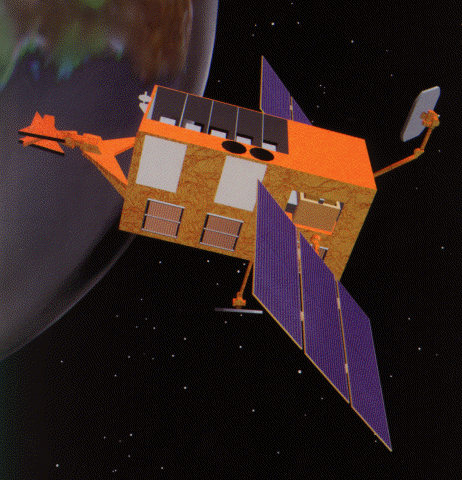
The Rossi XTE, a current X-ray telescope
With the Rossi XTE, still more new results are beginning to pour in about these mysterious signals, and it seems certain that Nature will be providing us yet more X-ray surprises. In the future, Chandra's unprecedented sensitivity may yield new and exciting data from these QPO sources. For although SCO X-1 is the brightest X-ray source in the sky (excluding the Sun), we need to look at its variability over very short time scales (about one thousandth of a second) to understand in detail what is happening. During this short period, only a few photons can be collected with current satellites, and the data looks "noisy". Chandra will aid us tremendously with its ability to collect more X-ray light than ever before from SCO X-1 and other low mass X-ray binary stars.
It seems almost impossible to imagine that all of our knowledge of the X-ray sky began with a humble rocket experiment a mere 35 years ago. Cosmic X-ray sources have demonstrated Nature's bounty of mysteries and wonders during that time, showering us with clues about the evolution and make-up of our awe-inspiring universe. And SCO X-1 led the way.
P.S. We eventually did discover X-rays reflected from the moon. Here is the image of that finding.
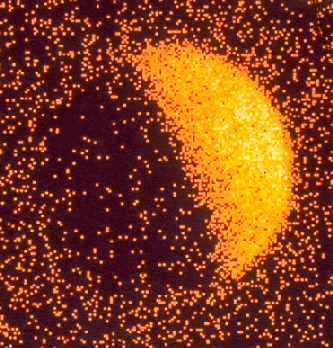
The Moon in X-ray Light taken by ROSAT
In these few pages, it is impossible to do more than just scratch the surface of the nature of SCO X-1. If you have any questions of your own, e-mail us and we will post the question and answer on this site...


